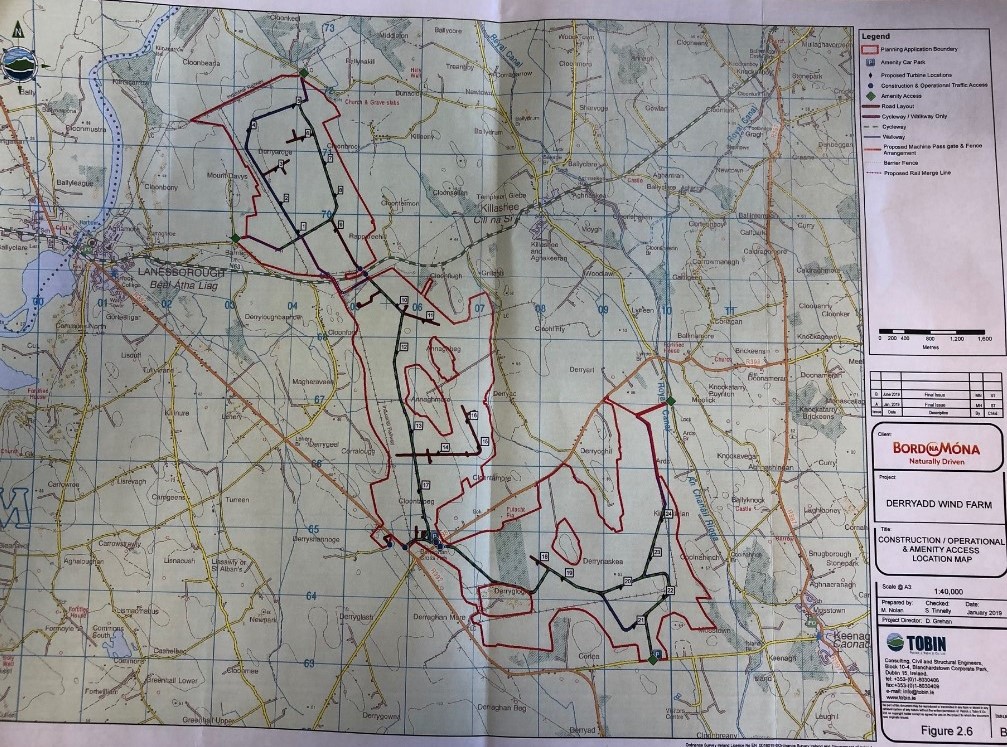An oral hearing into the Derryadd Wind Farm in Co. Longford heard last week that solar energy as an alternative at the site is not a viable option.
The issues of shadow flicker and the development of a battery energy storage system (BESS) close to the site were also brought to the fore by Bord na Móna Powergen which is seeking permission to develop the wind farm – and all associated infrastructure – comprising 24 wind turbines, nine of which will be located in Derryrogue Bog; eight in Derryadd Bog; and seven at Lough Bannow Bog – in south Co. Longford.
The hearing, which was chaired by John Desmond, planning inspector, An Bord Pleanála, was held to examine submissions made by a number of entities including the Irish Wildlife Trust; Transport Infrastructure Ireland (TII); Irish Society for the Prevention of Cruelty to Animals (ISPCA); Inland Fisheries Ireland (IFI); National Parks and Wildlife Service (NPWS); and the ‘No to Derryadd Wind Farm’ group – all of whom have highlighted their opposition to the development.
It was also told that the turbines will have a maximum blade tip height of 185m and that an electrical substation – including battery storage comprising eight containerised modules – is also proposed for construction at one of two locations on the site.
Why not solar?
Meanwhile, Siobhán Tinnelly on behalf of Bord na Móna Powergen confirmed to those gathered that the company had received a number of submissions suggesting that a solar development would be a better alternative to the proposed wind farm development.
She also pointed to the reasons why solar will not work at the site in Lanesboro.
To date, no ground mounted commercial scale solar farm that exports electricity into the national grid has been constructed in the Republic of Ireland.
She continued: “The commercial feasibility of this type of development will be dependent on the outcome of future Renewable Energy Support Scheme (RESS) auctions.
“In contrast, there are over 350 wind farms actively exporting electricity.
“A solar farm of equivalent electrical output would have a more significant footprint than the proposed wind farm and would have a higher potential environmental effect on hydrology and hydrogeology, traffic and transport and biodiversity at this location.”
Storage and safety
Meanwhile, on the day, the company also moved to reassure those who had raised concerns about the battery storage facility’s safety.
Tinnelly pointed out that BESS would include eight containerised modules with dimensions equal to that of standardised 40ft shipping containers.
She said the operating principal of the proposed BESS system is to offer a range of frequency regulation system services to the system operator – EirGrid and ESB Networks.
A number of submissions referred to concerns with respect to the fire safety associated with the proposed BESS and an independent fire safety report was commissioned in response to these concerns.
She continued: “That report pointed to the fact that the proposed site would be unmanned during normal operation but remotely monitored from a manned station.
“A fire exit would be required at both ends of the storage structure and based on the proposed development and associated fire prevention measures the potential fire impact is adequately controlled.”
Tinnelly went on to say that in the event of a fire there was “minimal potential” for fire spread due to construction of modules, the automated fire suppression system, the minimal storage of flammable material and the space spearation between BESS modules.
Below is Bord na Móna Powergen’s ‘construction/operational and amenity access’ location map.
“A fire safety management plan will also be agreed with Longford County Council’s chief fire officer in advance of commencement of works at the proposed development,” Tinnelly added.
The nuisance of shadow flicker
During the hearing numerous references were made to shadow flicker and its potential impact on residents close to the proposed wind farm site.
The company subsequently addressed that matter during proceedings.
Tinnelly said that in practice actual shadow flicker impacts “will always be less than predicted impacts due to worst-case modelling assumptions”.
Persistent shadow flicker effects may be considered a nuisance whereas effects over short, momentary periods may be considered acceptable.
She continued: “According to the Wind Energy Development Guidelines (2006) the acceptable limit for shadow flicker in Ireland is 30 hours per year with a maximum of 30 minutes per day.
“The Environmental Impact Assessment Review (EIAR) includes comprehensive mitigation measures which will be implemented in case of potential shadow flicker impact as a result of the proposed development.
“These measures include an initial screening assessment, the introduction, where required, of screening measures and finally a worst-case turbine shutdown scheme.”

